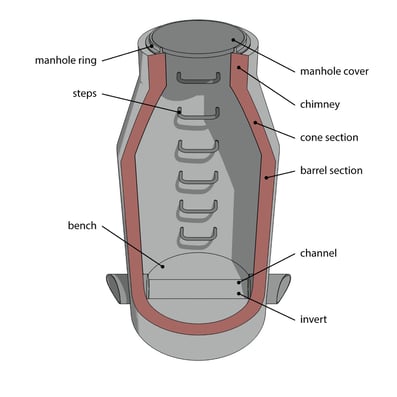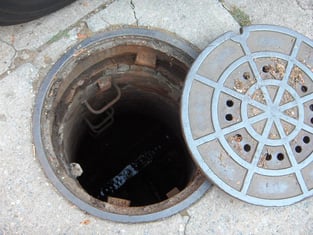Manholes give personnel and equipment access to sewer lines for inspection, testing and cleaning. They are built in areas where there is a change in the sewer line direction, slope, elevation, pipe size and junctions. The circular, usually cast iron plates seen on roads across the country cover underground confined spaces that serve a fundamental role in the making and success of a sewer system.
While manholes are just one part of a sewer system, they have a number of features and components.

Channel
The channel is a conduit located at the bottom of the manhole for wastewater to flow through from the manhole inlet to outlet.
Invert
The invert is the lowest point of the channel inside the manhole. Its characteristics are important for determining the function or flowline of a pipe.
The distance between a sewer pipe and a given benchmark, most often the top of the street, is the invert elevation. Before a sewer pipe can be installed successfully, the invert elevation is measured. A simple tape measure from the tallest point of the sewer pipe to the top of the road, or other given benchmark, is the invert elevation.
Bench
A manhole bench is the infill concrete poured between the walls of the manhole and the sewer pipes. Its main purpose is to direct flow back into the channel should a back-up occur in the manhole due to blockage. It can also be used by maintenance personnel to stand on at the bottom of the manhole when servicing the channel.
Steps
Manhole steps, most often made from concrete or plastic, are steps on the walls of the manhole for personnel to use to safely climb down when inspecting, cleaning or repairing. However, some utilities prefer to use a ladder to enter and exit.
Barrel Section
The barrel section of the manhole is the widest point, and essentially the body of the underground space. It connects the base of the manhole to the cone.
Chimney
The chimney of the manhole is the neck of the underground space, connecting the vertical manhole barrel section to the casting frame supporting the manhole lid/cover.
Cone
Shaped much like a cone, this area of the manhole sits between the chimney and the barrel section. The cone narrows the diameter of the manhole from the barrel into the chimney.
Lid/Cover and Ring
Closing the underground space from the outside are the manhole cover and ring.

Typically made of cast iron, the ring serves as the holder of the manhole cover, built just below ground level to ensure the lid doesn’t sit any higher or lower than the ground around it. In the U.S., manhole covers are almost always circular — though in other parts of the world they may be square or rectangular — and often are marked by a letter “S” in the middle.
WinCan sewer inspection software offers a manhole module to help track manhole condition, model features and build standards-compliant reports. Schedule a demo today to learn more.





